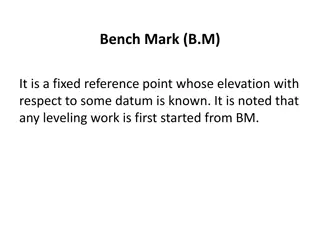Understanding Surveying Fundamentals
Learn the basic definitions of surveying, including concepts like plan transformation, map representation, angles, and the shape of the Earth's surface. Explore terms such as spheroid, meridian, horizontal plane, vertical line, and more.
Download Presentation

Please find below an Image/Link to download the presentation.
The content on the website is provided AS IS for your information and personal use only. It may not be sold, licensed, or shared on other websites without obtaining consent from the author. Download presentation by click this link. If you encounter any issues during the download, it is possible that the publisher has removed the file from their server.
E N D
Presentation Transcript
BASIC DEFINITIONS SURVEYING
PLAN Transformation of things from sheet to earth. MAP Transformation of things from earth to sheet.
ANGLE The difference in direction of two intersecting lines in movement.
THE EARTH SURFACE The earth is not a true sphere and a slightly flattened at the poles. It polar somewhat smaller in length (about 43.45 km) than that of its equatorial axis. axis is
THE EARTH SURFACE Any section of the earth parallel to the equator is a Great circle and any of its section parallel through the pole is an ellipse.
LEVEL SURFACE Any surface which is parallel to the mean spheroidal of the earth is called as level surface. Level surface is the curved surface every point lying upon the level surface will be distance from the center of the earth. at an equal
SPHEROID Spheroid is the curved line which is perpendicular to the direction of gravity. LEVEL LINE Level line is that line which lies on a level surface.
MERIDIAN It is line defined by the intersection imaginary plane, passing through the poles and any point on the earth surface level. of an
HORIZONTAL PLANE AND LINE Any place like glass sheet which is tangent to the level surface at any point is called as Horizontal plane. Through any point on the earth s surface, there can be only one horizontal plane but infinite horizontal lines. Any line which is lying on the horizontal plane is called Horizontal line.
VERTICAL PLANE AND LINE A perpendicular to the horizontal line is called Vertical Line. Any plane passing through that point and containing the vertical line is termed as Vertical Plane. Through any point on the earth surface, there can be only one vertical line but infinite vertical planes. line through a point is
PLUMB LINE The direction of the lines of force of earth's gravity field. In field surveying, it is defined by the direction of a freely suspended plumb-bob.
GRADE It is defined as slope of line. It is also called as gradient. Rise means how many units you move up or down from point to point. On the graph that would be a change in the y values. Run means how far left or right you move from point to point. On the graph, that would mean a change of x values
DATUM/ REFERENCE SURFACE A datum is a reference point from which measurements are made. It is an assumed surface used as a reference for the measurement of height and depth. Reduce Level (R.L) Reduce level of a point is vertical distance of point above or below datum. When height is increase reduce level also increase.
ELEVATION It is vertical distance of point above or below the reference surface (Datum). When elevation are with respect to the earth s surface , the datum is the mean sea level.
SEA LEVEL Mean sea level is an average level of the surface of one or more of Earth's bodies of water from which heights such as elevation may be measured.
LATITUDE Measurement of a position north or south of the equator is called latitude. LONGITUDE Measurement of how far a position is east or west is called longitude.























